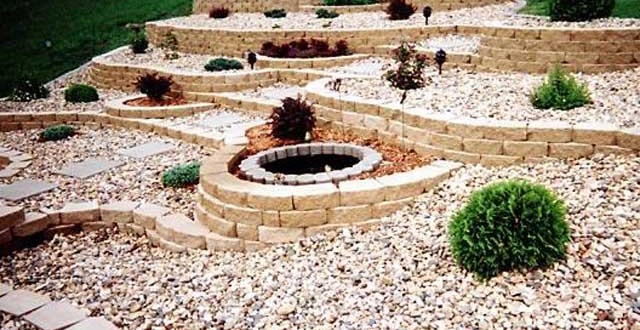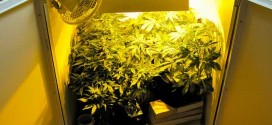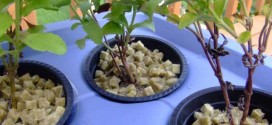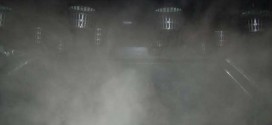Xeriscaping
Xeriscaping and xerogardening refer to landscaping and gardening in ways that reduce or eliminate the need for supplemental water from irrigation. It is promoted in regions that do not have easily accessible, plentiful, or reliable supplies of fresh water, and is gaining acceptance in other areas as climate patterns shift. Although xeriscaping may be an alternative to various types of traditional gardening, it is usually promoted as a substitute for Kentucky bluegrass lawns. Kentucky blugrass is commonly used in American suburban landscaping. A cool-season grass, it is well suited to high foot traffic and recreation. However, it is difficult to grow in sandy or compacted soil as well as fast draining sites like slopes, especially those facing the sun.
For these reasons, Kentucky bluegrass requires more water use than necessary in arid regions.
The word xeriscaping is a portmanteau of xeros ξήρος (Greek for “dry”) and landscaping, and xeriscape is used for this style of garden. Xeriscaping refers to a method of landscape design that minimizes water use. Many Denver Water employees helped coin the term xeriscape, and Xeriscape and the xeriscape logo are registered trademarks of Denver Water, the water department of Denver, Colorado.
In some areas, terms such as water-conserving landscapes, drought-tolerant landscaping, and smart scaping are used instead. Plants whose natural requirements are appropriate to the local climate are emphasized, and care is taken to avoid losing water to vaporation and run-off. The specific plants used in xeriscaping depend upon the climate. Xeriscaping is not the same as “zero-scaping” (in which the designed landscape consists mostly of hard surfaces, with a few plants as accent features), and can look quite lush and colorful. Xeriscaping is also different from natural landscaping, because the emphasis in xeriscaping is on selection of plants for water conservation, not necessarily selecting native plants.
Advantages
Cacti are one of the low-water-consuming plants used in Xeriscaping.
Lowers consumption of imported or ground water.
More water available for other domestic and community uses and the environment.
Less time and work needed for maintenance effort (no lawns to cut).
Xeriscape plants in appropriate planting design, and soil grading and mulching, takes full advantage of rainfall retention.
When water restrictions are implemented, by municipality or water costs, xeriscape plants will tend to survive and thrive, while more ornamental plants may be unable to adapt.
Can be visually more interesting than lawns.
Disadvantages
Unsuitable for some traditional uses of Kentucky bluegrass, such as baseball and soccer fields.
Sometimes deemed aesthetically inferior by traditionalists.
X-ratings
In 1982 the Denver water Department’s Xeriscape Demonstration Garden was dedicated with an “X-rated party”. The X stood for Xeriscape, but the humor was intended. Garden centers continued with a system of X-ratings, from X to XXX, to specify how much water individual types of plants need.
 Denver Water summary
Denver Water summaryThe Xeriscape concept has been denoted by Denver Water in 7 basic principles:
1. Plan and design – Create a diagram, drawn to scale, that shows the major elements of the landscape, including house, driveway, sidewalk, deck or patio, existing trees and other elements. Once a base plan of an existing site has been determined, the creation of a conceptual plan (bubble diagram) that shows the areas for turf, perennial beds, views, screens, slopes, etc. is undertaken. Once finished, the development of a planting plan that reinforces the areas in the appropriate scale is done.
2. Soil amendment – Most plants will benefit from the use of compost, which will help the soil retain water. Some desert plants prefer gravel soils instead of well-amended soils. Plants should either fit the soil or soil should be amended to fit the plants.
3. Efficient irrigation – Xeriscape can be irrigated efficiently by hand or with an automatic sprinkler system. Zone turf areas separately from other plants and use the irrigation method that waters the plants in each area most efficiently. For grass, use gear-driven rotors or rotary spray nozzles that have larger droplets and low angles to avoid wind drift. Spray, drip line or bubbler emitters are most efficient for watering trees, shrubs, flowers and groundcovers. If watering by hand, avoid oscillating sprinklers and other sprinklers that throw water high in the air or release a fine mist. The most efficient sprinklers release big drops close to the ground. Water deeply and infrequently to develop deep roots. Never water during the day to reduce water lost to evaporation. With the use of automatic sprinkling systems, adjust the controller monthly to accommodate weather conditions. Also, install a rain sensor to shut off the device when it rains.
4. Appropriate plant and zone selection – Different areas in a yard receive different amounts of light, wind and moisture. To minimize water waste, group together plants with similar light and water requirements, and place them in an area that matches these requirements. Put moderate-water-use plants in low-lying drainage areas, near downspouts, or in the shade of other plants. Turf typically requires the most water and shrub/perennial beds will require approximately half the amount of water. Dry, sunny areas support low-water-use plants that grow well in our climate. Planting a variety of plants with different heights, color and textures creates interest and beauty.
5. Mulch – Mulch keeps plant roots cool, prevents soil from crusting, minimizes evaporation and reduces weed growth. Organic mulches, such as bark chips, pole peelings or wood grindings, should be applied 2 to 4 inches deep. Fiber mulches create a web that is more resistant to wind and rain washout. Inorganic mulches, such as rocks and gravel, should be applied 2 to 3 inches deep. Surrounding plants with rock makes the area hotter; limit this practice.
6. Alternative turf – Native grasses (warm-season) that have been cultivated for turf lawns, such as buffalo grass and blue grama, can survive with a quarter of the water that bluegrass varieties need. Warm-season grasses are greenest in June through September and straw brown the rest of the year. Native grasses (cool season) such as bluegrass and tall fescue, are greenest in the spring and fall and go dormant in the high heat of the summer. New cultivars of bluegrass, such as Reveille, and tall fescue, can reduce typical bluegrass water requirements by at least 30 percent. Fine fescues can provide substantial water savings and is best used in areas that receive
low traffic or are in shady locations. Use the appropriate grass and limit the amount of grass to reduce the watering and maintenance requirements.
7. Maintenance – All landscapes require some degree of care during the year. Turf requires spring and fall aeration along with regular fertilization every 6 to 8 weeks. Keep the grass height at 3 inches and allow the clippings to fall. Trees, shrubs and perennials will need occasional pruning to remove dead stems, promote blooming or control height and spread. Much of the removed plant material can be shredded and used in composting piles.
 Karshika Keralam – A site for Agricultural Enthusiasts
Karshika Keralam – A site for Agricultural Enthusiasts




